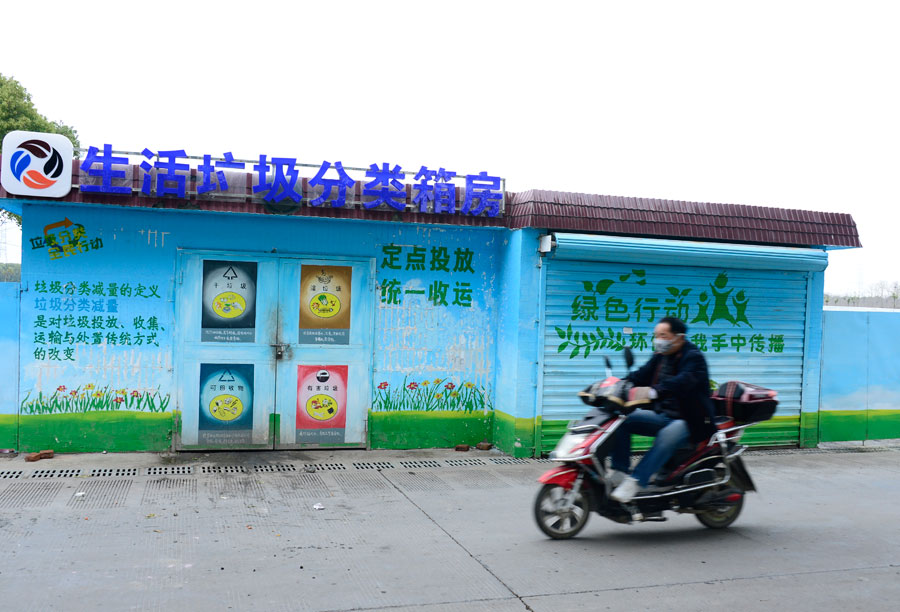
From the People's Daily app.
And this is Story in the Story.
As one of China's pioneer cities when it comes to sorting trash, Shanghai announced that all residential communities in every district would be required to have a trash sorting program by 2020.
The measure is aimed at reducing dry waste volume by 15 percent for 2020, while increasing wet waste, mainly kitchen leftovers, which can be used as compost or fertilizer, by 80 percent. The daily volume of recyclables, including plastic and paper, is also expected to rise roughly 70 percent.
Individuals and working units alike will be held accountable for sorting and disposing their garbage. Individuals who fail to do so could receive fines upwards of $30, with fines ranging between $800 to $8,000 for work units who failed to comply.
Today's Story in the Story looks at how one person has turned waste collection into a personal hobby that has since become a one-man historical preservation drive.

A garbage sorting facility in suburban Shanghai. (Photo: China Daily)
At the Shanghai International Hobbycraft Expo, Ma Jiqiu's booth featured lamps, wall hooks and handmade items he made from old fans, telephones, machine parts and thermos bottles, drew curious visitors.
"I would like to buy a lamp for my new cafeteria," said a woman after inquiring about the price and delivery conditions.
"His design is unique and nostalgic at the same time. It will surely catch the eyes of some people at my cafe," the woman said.
The 40-year-old Ma is, in his own words, a "waste collector" who got into the business of repurposing objects after his company went bankrupt years ago.
But he doesn't just collect whatever people discard, every object needs to be aesthetically pleasing by his standards.
"I don't care how old an object is. I am more interested in form and design than the age," he explained.
When Ma first started, he would repair some items and later sell them. He eventually realized many of the items could not be repaired. Reluctant to discard them, he gave them a new lease on life, and turned them into something else.
"I like to make lamps the most, because they make you feel warm, safe and they create an intimate ambience," Ma said.
Ma, who also works as a prop designer for films, named his workshop "Save the Waste Studio," and himself "the savior of waste," because he believes it is his mission in life to give used objects a new purpose.
The most important objects he has salvaged are electricity meters. He even established a private museum for them, the first of its kind in China.
Located at No. 99 Donglin Street in the Sanlin old town in suburban Shanghai, the museum is home to over 1,000 vintage electricity meters, which only represents one-fifth of Ma's entire collection.

Ma Jiqiu shows off table lamps he built from recycled objects at his booth at the Shanghai International Hobbycraft Expo. (Photo: China Daily)
Ma said the meters tell the story of how electricity was developed, not just in Shanghai, but in human civilization, because they were made in 16 different countries. The first electricity meter he found was a delicate item covered in glass and made in the 1940s in Canada.
"I was struck by its beauty and design, but didn't know what it was," Ma recalled. "I was later told it was a 'fire meter,' an old colloquial name for electricity meter in Shanghai."
Since that moment, Ma kept a constant lookout for these old meters. As there were hardly any people interested in this object, he managed to build up his collection quickly.
All the meters in his collection were salvaged in Shanghai. And the oldest was made around 1905. The majority of them were made between 1910 and the 1940s.
As his unique collection grew, so did his knowledge of the city. For example, he shared that it was through these meters he learned about the opening of the first power plant in Shanghai in 1879 and the inaugural lighting up of 16 road lamps on the Bund in 1882, which marked the beginning of power supply in the city.
"Shanghai was the first city in China to use electricity. Soon after the technology was developed in the West, it was introduced to Shanghai," says Ma.
"With the introduction of electricity meters, electrical power could be measured, widely used and merchandized. These objects remind us of the past and the importance of electricity and saving power," he added.
"These meters belong in a proper museum, but because there is no museum about electricity in Shanghai, I built one myself. It is my mission to keep these objects as evidence of the city's history," he said.
(Produced by Nancy Yan Xu, Lance Crayon, Brian Lowe, and Chelle Wenqian Zeng. Music by: bensound.com. Text from China Daily.)


